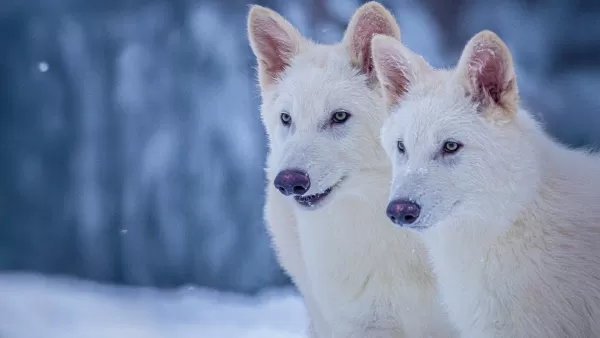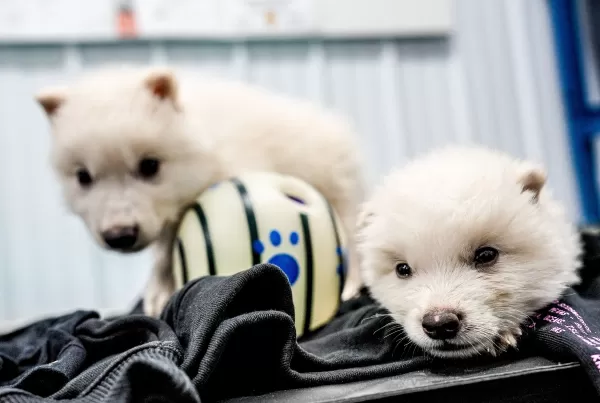Science Revives Extinct Dire Wolves
Bringing a super-sized canine back from extinction after 12,500 years might sound like a plot straight out of a blockbuster movie, complete with dramatic special effects. However, it's not just fiction; it's reality, thanks to the efforts of biotech company Colossal Biosciences. They've successfully reintroduced three dire wolves—Romulus, Remus, and their younger sister, Khaleesi—to the world, housing them in a secret location in the US.
 Romulus and Remus at three months old
Romulus and Remus at three months old
Colossal Biosciences achieved this remarkable feat by using DNA from the common gray wolf, employing gene-editing techniques, and utilizing domestic dog surrogates. The result? Three awe-inspiring, massive, white dire wolves that would make any mother of dragons proud.
“I could not be more proud of the team. This massive milestone is the first of many coming examples demonstrating that our end-to-end de-extinction technology stack works,” said CEO of Colossal Ben Lamm.
“Our team took DNA from a 13,000 year old tooth and a 72,000 year old skull and made healthy dire wolf puppies. It was once said, ‘any sufficiently advanced technology is indistinguishable from magic.’ Today, our team gets to unveil some of the magic they are working on and its broader impact on conservation.”
 Romulus and Remus at one month old
Romulus and Remus at one month old
This isn't the first time Colossal Biosciences has made headlines. They previously engineered a Colossal Woolly Mouse, essentially a mouse sporting a very shaggy hipster coat, to mimic a mammoth phenotype. This was achieved through computational analysis of 59 woolly, Columbian, and steppe mammoth genomes, spanning from 3,500 to over 1,200,000 years old. Critics argue that the dire wolves are more like normal wolves in fancy dress, suggesting that the available dire wolf DNA isn't sufficient to create a true genetic clone.
Colossal Biosciences' motives go beyond creating social media buzz and owning impressive pets. The company aims to use its findings to help preserve current species for future generations.
“The de-extinction of the dire wolf and an end-to-end system for de-extinction is transformative and heralds an entirely new era of human stewardship of life,” said Dr. Christopher Mason, a scientific advisor and member of the board of observers for Colossal.
“The same technologies that created the dire wolf can directly help save a variety of other endangered animals as well. This is an extraordinary technological leap in genetic engineering efforts for both science and for conservation as well as preservation of life, and a wonderful example of the power of biotechnology to protect species, both extant and extinct.”
To ensure the well-being of these dire wolves, Colossal Biosciences has collaborated with the American Humane Society and the USDA to establish a 2,000+ acre preserve as their home. The wolves are cared for by a dedicated team, ensuring they receive the attention and care they need as the new superstars of the animal kingdom.
- 1 Silent Hill 2 Remake Confirms Xbox, Switch Release in 2025 Feb 08,2025
- 2 Connect Asus ROG Ally to TV or Monitor: Easy Guide Apr 06,2025
- 3 "Persona Games and Spin-Offs: Complete Chronological List" Apr 09,2025
- 4 Dragon Soul Tier List: Ultimate Guide May 12,2025
- 5 The Best Marvel Contest of Champions Tier List for 2025 Mar 19,2025
- 6 Fix 'Can't Connect to Host' Error in Ready or Not: Quick Solutions Jun 13,2025
- 7 Assassin's Creed Shadows: Max Level and Rank Cap Revealed Mar 27,2025
- 8 "Discover All Templar Locations in Assassin’s Creed Shadows - Spoiler Guide" Apr 04,2025
-
Top Arcade Classics and New Hits
A total of 10
-
Addictive Arcade Games for Mobile
A total of 10
-
Android Apps for Video Content Creation
A total of 10












![Roblox Forsaken Characters Tier List [UPDATED] (2025)](https://img.actcv.com/uploads/18/17380116246797f3e8a8a39.jpg)















